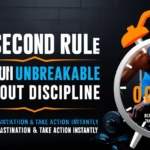Introduction
We’ve all been there. The alarm screams its unwelcome tune, signaling the start of another day and, more importantly, your scheduled workout. A battle erupts in your mind – the cozy warmth of the bed versus the demanding pull of your fitness goals. Often, comfort wins. Building consistent, Unbreakable workout discipline feels like scaling a sheer cliff face, fraught with internal resistance and the siren song of procrastination. But what if I told you there’s a deceptively simple yet incredibly powerful tool that can help you conquer this struggle? It’s called the 3-Second Rule.
This isn’t some groundbreaking scientific discovery or a complex psychological technique. The 3-Second Rule is elegantly straightforward: when the urge to skip your workout arises, you have three seconds to start taking action towards it. That’s it. No lengthy internal debates, no weighing the pros and cons, no bargaining with yourself. Just a swift, decisive move within those crucial three seconds that propels you towards your fitness commitment.
In a world saturated with elaborate fitness plans and motivational gurus, the simplicity of the 3-Second Rule is its strength. It cuts through the mental clutter and taps into the power of immediate action, bypassing the inertia that often derails our best intentions. But how does something so simple yield such profound results in building unbreakable workout discipline? Let’s delve deeper into the mechanics and benefits of this powerful technique.
The Science Behind the Snap Decision
The effectiveness of the 3-Second Rule lies in its ability to circumvent the brain’s natural inclination towards comfort and the avoidance of perceived discomfort. Our brains are wired to conserve energy and seek pleasure, which often translates to choosing rest over exertion. When faced with the prospect of a workout, this ingrained tendency can trigger a cascade of rationalizations and excuses.
The 3-Second Rule acts as a circuit breaker in this process. By forcing an immediate response, it minimizes the time the prefrontal cortex – the part of the brain responsible for rational thought and decision-making – has to engage in a potentially self-sabotaging internal dialogue. Instead, it leverages the power of the basal ganglia, the brain region associated with habit formation and automatic behaviors.
Think about it: tying your shoelaces before a run, grabbing your gym bag, or even just standing up from the couch. These are small actions, but they initiate a chain of events that makes it significantly harder to back out. The momentum of that initial movement carries you forward, reducing the cognitive load associated with starting the workout.
Furthermore, the 3-Second Rule taps into the principle of implementation intention. This psychological concept suggests that forming specific “if-then” plans significantly increases the likelihood of goal achievement. In the context of the 3-Second Rule, the “if” is the urge to skip your workout, and the “then” is the immediate action you take within those three seconds. This clear trigger-response mechanism primes your brain for action and reduces the ambiguity that often leads to procrastination.
Implementing the 3-Second Rule: Practical Strategies
While the core principle is simple, effectively integrating the 3-Second Rule into your fitness routine requires conscious effort and strategic implementation. Here are some practical ways to make it work for you:
1. Identify Your Workout Triggers: Understand the specific times and situations when the urge to skip your workout is strongest. Is it the early morning alarm, the post-work exhaustion, or the lure of social media? Recognizing these triggers allows you to be mentally prepared to deploy the 3-Second Rule when they arise.
2. Pre-Commit to Small Initial Actions: Before your scheduled workout, decide on the tiny, almost effortless action you will take within those crucial three seconds. This could be:
- Morning Workout: Swinging your legs out of bed, putting on your workout clothes laid out the night before, walking towards your pre-packed gym bag.
- Lunch Break Workout: Standing up from your desk, putting on your headphones, heading towards the stairs instead of the elevator.
- Evening Workout: Turning off the TV, putting on your sneakers, stepping outside for a quick breath of fresh air.

The key is to make this initial action so easy that your resistance is minimal. It’s about breaking down the seemingly daunting task of a full workout into an almost negligible first step.
3. Visualize Success: Spend a few moments visualizing yourself successfully executing the 3-Second Rule and the positive feelings that follow – the sense of accomplishment, the surge of energy, the progress towards your goals. This mental rehearsal strengthens your resolve and makes it more likely that you’ll act decisively when the moment comes.
4. Eliminate Friction: Make it as easy as possible to start your workout by minimizing any obstacles. Lay out your workout clothes, pack your gym bag, prepare your water bottle, and have your workout plan readily accessible. Reducing friction removes potential excuses and makes that initial three-second action even more effortless.
5. Track Your Wins: Keep a record of the times you successfully implemented the 3-Second Rule. This visual reinforcement of your progress can be incredibly motivating and build momentum. Even small victories contribute to a growing sense of control and discipline.
6. Be Kind to Yourself (Initially): Don’t aim for a grueling hour-long workout every time you implement the 3-Second Rule, especially when starting. The initial goal is simply to start. Once you’ve taken that first small step, the likelihood of continuing with a more substantial workout significantly increases. Even a 10-minute walk or a few bodyweight exercises are a win.
7. Adapt and Adjust: The specific initial actions that work for you might evolve over time. Pay attention to what consistently helps you overcome inertia and adjust your strategies accordingly. The 3-Second Rule is a flexible tool that can be tailored to your individual needs and preferences.
The Long-Term Impact: Building Unbreakable Discipline
The beauty of the 3-Second Rule lies not just in its immediate effectiveness but also in its ability to foster long-term, unbreakable workout discipline. Here’s how:
1. Habit Formation: Consistent application of the 3-Second Rule gradually transforms the act of starting your workout from a conscious decision to an automatic response. By repeatedly associating the urge to skip with immediate action, you are essentially training your brain to bypass resistance and move directly into workout mode. This automaticity makes it significantly easier to stay consistent over time.
2. Building Momentum: Each successful implementation of the 3-Second Rule generates a small sense of accomplishment, which fuels further action. These small wins accumulate, creating a positive feedback loop that strengthens your motivation and makes it easier to overcome future resistance.
3. Overcoming Mental Barriers: The 3-Second Rule teaches you to trust your pre-commitment and to act despite fleeting feelings of reluctance. This builds mental toughness and reduces the power of negative self-talk and excuses. You learn that you don’t always need to feel motivated to take action; sometimes, action itself generates motivation.
4. Fostering a Bias for Action: By consistently choosing action over inaction in those critical three seconds, you cultivate a general bias for action in other areas of your life as well. This spills over into other healthy habits and contributes to a greater sense of control and agency.
5. Creating a Strong Identity: As you consistently stick to your workouts, your identity as a “fit person” strengthens. This internal shift in self-perception makes it easier to prioritize fitness and resist behaviors that are inconsistent with this identity. The 3-Second Rule becomes a tool for reinforcing this positive self-image.
Beyond the Workout: Applying the 3-Second Rule to Other Areas of Life
The principles of the 3-Second Rule extend far beyond the realm of fitness. It can be a powerful tool for tackling procrastination and building discipline in various aspects of your life:
- Work: When you feel the urge to put off a challenging task, give yourself three seconds to open the relevant document or send that initial email.
- Healthy Eating: When a craving for unhealthy food strikes, take three seconds to reach for a piece of fruit or a glass of water.
- Learning: When you feel resistant to studying, give yourself three seconds to open your textbook or start reviewing your notes.
- Creative Pursuits: When writer’s block hits, take three seconds to jot down a single sentence or open your design software.
The underlying principle remains the same: interrupt the cycle of procrastination with immediate, small action.
The Power of Simplicity
In a world that often glorifies complexity, the 3-Second Rule stands out for its elegant simplicity. It doesn’t require elaborate planning, expensive equipment, or years of training. It’s a readily accessible tool that anyone can implement immediately. Its power lies in its ability to harness the momentum of initial action and bypass the often-paralyzing grip of overthinking.
Building unbreakable workout discipline is not about becoming a superhuman with unwavering willpower. It’s about developing effective strategies to navigate the inevitable dips in motivation and overcome the natural human tendency towards inertia. The 3-Second Rule offers a potent yet simple solution. By learning to act decisively within those crucial three seconds, you can break free from the cycle of procrastination, build lasting habits, and finally achieve the consistent fitness routine you’ve always desired. So, the next time that alarm goes off, or that urge to skip creeps in, remember the 3-Second Rule. Give yourself three seconds, take that first small step, and watch as unbreakable discipline begins to take root. Your fitter, stronger self awaits.




[…] Understanding the Importance of Motivation in Fitness […]
[…] Why 2025 is Your Year for Fitness? […]
[…] Assess Your REALISTIC Starting Point (Honesty is Key): […]